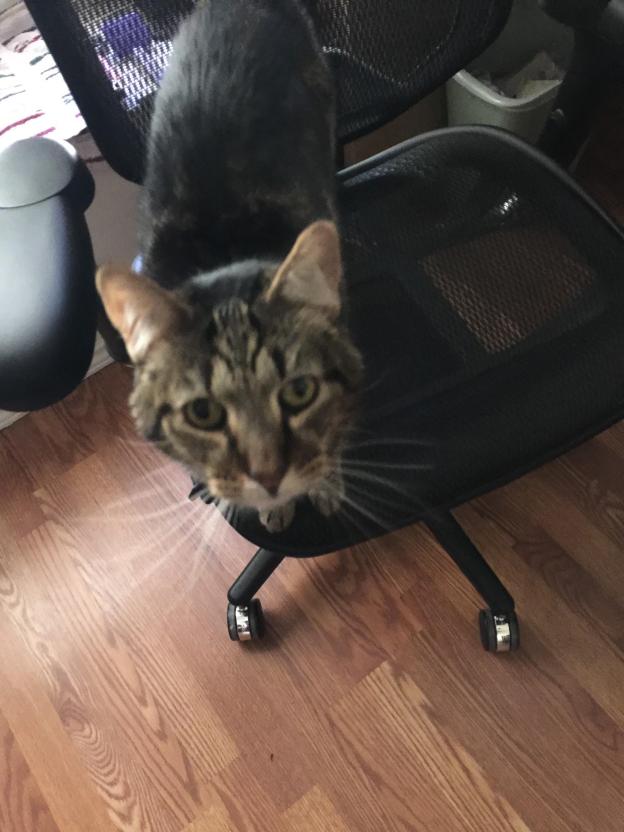In the last month, Garrus has made his preference for wet food quite clear and does not eat his kitten kibble much. I spoke to Dr R about it and she assured me that cats are very texture-oriented and some prefer the texture of wet food to dry food. Since he still needs to gain weight and I was worried that he was actually losing weight trying to hold out for wet food, Dr R encouraged me to give him small portions of wet food and increase it accordingly if that was all he was eating.
Yesterday Aaron gave him his dinner and tried an experiment by sprinkling some kitten kibbles on top of the wet food. Garrus ate them—hooray! Both Boudicca and Garrus need the extra calories so I replicated Aaron’s experiment and added kibbles on top of their breakfasts this morning. I was pleased to see that my cats, who had been so patient as I prepared their meal even though they were so hungry, ate everything I gave them! Charlie, in this typical squeaky fashion, was delighted when I offered him a few morsels of wet food on a spoon. (Since he is at a healthy weight, he gets a very small amount of wet food as a treat. As he is not a fussy eater and remains a very busy guy, Charlie has no problem eating most or all of his dry food every day.)

“Is it dinner time yet?” Garrus is polite and patient but most persistent when he is hungry and waiting for me to give him wet food.
Having a cat with exacting and/or mercurial eating preferences can be a challenge for any pet owner. Here are a few tips:
- Understand how cats choose what food they like. Texture, odor, and taste are hugely important to cats. For example, Boudicca does not like chicken or turkey-flavored wet food but loves seafood varieties. She is also particular about the texture: she likes Friskies Paté but not the Shreds or Flaked or the generic brand we bought from the grocery store. Some cats will prefer one brand over the other based on taste, texture, smell, mouth feel, or other factors. Temperature and even presentation can make a difference. Case in point, while I can spread out the food I serve for Garrus, the same tactic will not work for Queen B. I have to spoon her food into a pile and “fluff” it for her. If after she’s eaten half of it and it’s smooshed down onto the plate, she will stop eating but if I resculpt it into a fluffed pile, she will finish what I’ve given her.
- More protein, less carbohydrates. Cats are carnivores and they need at least 40% protein to maintain a healthy weight and muscle composition. Carefully read the nutrition label on the dry and wet food you’re offering your cat. Is it comprised of more carbohydrates and fillers or is protein-heavy?
- Food allergies. Cats can develop food allergies. An elimination diet may help identify any allergies. Make sure you discuss this with your vet first for more information and address concerns before you try an elimination diet.
- Dental issues. If a cat is experiencing dental pain, it is understandable that his or her appetite might decrease. Crunchy kibbles may further irritate inflamed gums or bad teeth. If you suspect that your cat is having a dental problem, consult your vet!
- Rotation. If you want to switch to a new cat food, do so slowly. Sudden changes can cause upset tummies, diarrhea, appetite loss, and other issues. Here’s a handy breakdown to utilize:
- 75% current food, 25% new food for a few days. Is your cat eating well? All good? Move on to the next step.
- 50% current food, 50% new food for another few days. Keep an eye on your cat’s behavior. Eating normally? No indication of GI troubles? You may pass go.
- 75% new food, 25% current food. This may take a week or, for more fastidious cats, 10 days to two weeks.
- Make your cat hungry. I know that sounds cruel but some cats do better when they are not free-fed.
- Food o’clock. Begin offering your cat two established meals a day. (See #5.)
- Playtime. Play and exercise can stimulate a cat’s appetite.
- High quality. Again, check the ingredients and nutrition content of the cat food you’re buying. Don’t feed your cat junk.
- Canned vs dry food. Boudicca ate dry food only most of her life but now eats both wet and dry food. Garrus had eaten only wet food at the shelter due to his dental issues before we transitioned him to kibble. Now his preference for wet food reasserted itself and we’re giving him that because he needs extra calories. Some owners hate canned food while others detest dry food, so there is a lot of information from both camps biased toward one or the other. My advice? Talk to your vet, ask questions, and carefully evaluate the information sources you come across.
Stay tuned for Part Two!
Louis Catorze refuses to eat wet food, so this makes our decision easy! 🌞👑
LikeLike
I’m glad you found the post useful!
Feel free to pass along affection to Louis Catorze on my behalf! 🙂
LikeLiked by 1 person